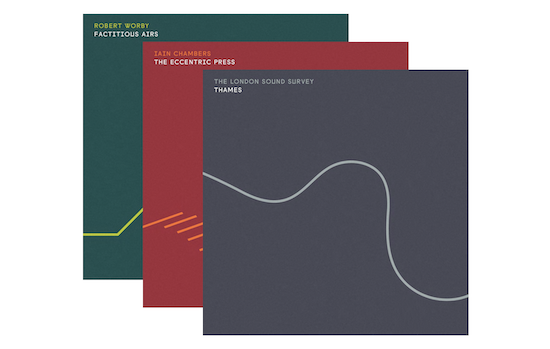According to Lawrence English, it is essential for an artist making field recordings to be a listener that listens. “Any listening undertaken during the completion of field recording must be engaged and conscious”, he posits. Such a field recording then becomes “agentive, in that it is temporal and rooted in the artist’s creative engagements in place and time”. The work of the London Sound Survey’s Ian Rawes seems to be in line with this approach. In a constant state of creation and growth since 2008, his archive of field recordings documenting London’s soundscape is a sonic history both engaged and engaging. A living collection of sounds that bears witness to the passage of time while chronicling spatial and social meanderings.
Thames, released on composer Iain Chambers’s new label Persistence of Sound, is just a snippet of this monumental work. Yet, even in such reduced breadth, it manages to capture the essence of the project and all its facets. Rawes listens to the river in various locations, times, and seasons to discover subtle dynamics. The opening ‘Tower Bridge: North Bascule Chamber’ reveals the jangle and melodious ruckus of machinery as the bridge is raised and then lowered again. The metallic grinding and hum of engines resonates with a haunting musicality.
Elsewhere, he contrasts the flora and fauna in the Allhallows Marshes at day and night, in summer and springtime. Here, the busy buzzing of insects and chirping of birds makes way for the nostalgic croak of frogs. But even in these secluded parts of the river, there are traces of society seeping in. Flagpoles and halyards clash a soothing song on ‘The Albert Basin’. A lethargic ship passes by. A horn honks in the distance. Imbued with Rawes’s personal touch, the transporting, affective pieces dare the listener to engage in a game of associations.
While Rawes will later return from the marshes and revisit Tower Bridge on ‘Tower Bridge: South Bascule Chamber’ and ‘Tower Bridge: Machine Room’, the sonic scenery is almost unrecognisable. Now, the rain clinks gently somewhere outside the chamber, providing a backdrop for the solemn whir of electric motors. Abruptly, the motors stop. Previously obscured noises reveal themselves and allow ears to adjust to this new luminosity. The album ends.
If Thames embodies Persistence of Sound’s fondness for field recordings, a pristine perspective of the beauty of sound, Chambers’s own The Eccentric Press is then representative of the label’s musique concrète tendencies. Removed from the position of listener, his compositional touch is distinct while he uses materials from Sounds of Changes – a pan-EU project documenting the endangered sounds of industry and domesticity – to create hypnotic industrial symphonies. The approach is two-fold. First, he finds intrinsic musicality in the machinery’s cyclical lives. Then he shapes them into something new by emphasising and superimposing their compelling characteristics.
On the first of the two pieces, ‘The Eccentric Press / Die Exzenterpresse’, Chambers overlays atmospheric sounds from the Wuppertaler Schwebebahn Station in western Germany with the frenzied drumming of sewing machines and high pitched ringing of mechanical clocks. Despite the noises of industry usually evoking thoughts of dehumanisation and labour exploitation, Chambers’s compositions feel sanguine, almost organic. Wonderful cadences crafted out of swishes and hollow plonks move across the stereo image and disappear under the weight of a typewriter. Pops and clicks of unknown origin join into a four-on-the-floor rhythm.
With the first track often devoted to finding a rhythmic footing, ‘Maudslay Engine’ becomes a slave to melody. After a menacing fighter jet pierces the silence, metal cutting contraptions start droning in harmony, veering towards textures that might belong to a Prurient or Tim Hecker record. Meanwhile, linotype machines and start-up sounds of vintage IBM computers croon a surprisingly lyric tune, interrupted occasionally by sharper pulses and ultimately consumed by a fire truck siren.
The final of the initial three Persistence of Sound releases, Robert Worby’s Factitious Airs, ventures farthest from the various found and sampled sounds it exploits. Not content with their natural state and inspired by the electronic works of Karlheinz Stockhausen and Pierre Henry, Worby plucks noises from their natural habitat, mangles them into a pulp, and rearranges them into idiosyncratic experiments.
‘Stumble Bum Junk Heap’ rings true to its name while it staggers and jumbles all over the place, carried by clashing and crashing noises. On ‘Cody’s Receiver’, bits of shortwave radio are woven into a volatile, digital-sounding mesh that emits reverberations of James Ferraro’s work. It’s like listening to a radio sent from the future, but broadcasting from the past. Later, ‘The Blind Momentum of Catastrophe’ builds from pure entropy as distorted pianos are piled upon each other to create utter chaos.
Finally, on ‘Drawing the Nerves’, a single sentence is broken up, its original meaning destroyed, only to be resurrected into a messy concoction from beyond the uncanny valley. There is little connective tissue between the ten abstract pieces, each one existing in a universe of its own, yet the record feels strangely cohesive. A fitting third release for Persistence of Sound’s mission statement.





